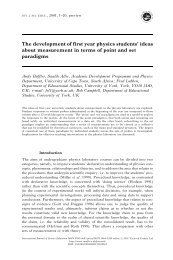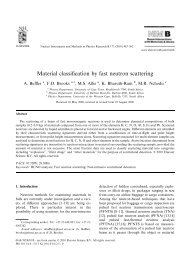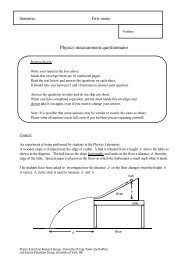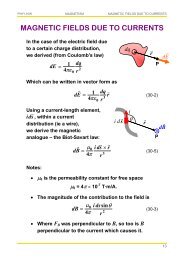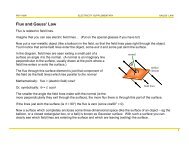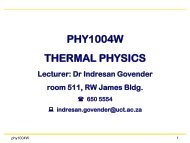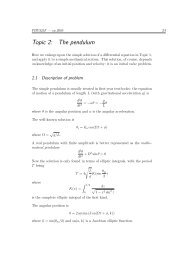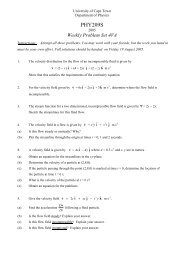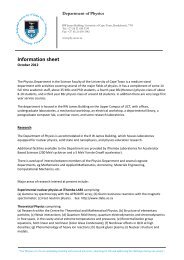PHY2014F Vibrations and Waves Part 3 - University of Cape Town
PHY2014F Vibrations and Waves Part 3 - University of Cape Town
PHY2014F Vibrations and Waves Part 3 - University of Cape Town
You also want an ePaper? Increase the reach of your titles
YUMPU automatically turns print PDFs into web optimized ePapers that Google loves.
<strong>University</strong> <strong>of</strong> <strong>Cape</strong> <strong>Town</strong><br />
Department <strong>of</strong> Physics<br />
<strong>PHY2014F</strong><br />
<strong>Vibrations</strong> <strong>and</strong> <strong>Waves</strong><br />
<strong>Part</strong> 3<br />
Travelling waves<br />
Boundary conditions<br />
Sound<br />
Interference <strong>and</strong> diffraction<br />
… covering (more or less)<br />
French Chapters 7 & 8<br />
Andy Buffler<br />
Department <strong>of</strong> Physics<br />
<strong>University</strong> <strong>of</strong> <strong>Cape</strong> <strong>Town</strong><br />
<strong>and</strong>y.buffler@uct.ac.za<br />
1
Problem-solving <strong>and</strong> homework<br />
Each week you will be given a take-home<br />
problem set to complete <strong>and</strong> h<strong>and</strong> in for marks ...<br />
In addition to this, you need to work through the following<br />
problems in French, in you own time, at home. You will not be<br />
asked to h<strong>and</strong> these in for marks. Get help from you friends, the<br />
course tutor, lecturer, ... Do not take shortcuts.<br />
Mastering these problems is a fundamental aspect <strong>of</strong> this course.<br />
The problems associated with <strong>Part</strong> 3 are:<br />
7-1, 7-2, 7-3, 7-4, 7-5, 7-6, 7-7, 7-8, 7-9, 7-10, 7-11, 7-15, 7-17,<br />
7-18, 7-19, 7-21<br />
You might find these tougher:<br />
2
Travelling waves<br />
For a string clamped at both ends the displacement <strong>of</strong> the<br />
n th normal mode is<br />
⎛nπ<br />
x⎞<br />
yxt ( , ) = Asin⎜ ⎟cosω<br />
n<br />
t ω<br />
n<br />
=<br />
⎝ L ⎠<br />
Since L n λ nπ<br />
vt 2π<br />
vt<br />
= then =<br />
2 L λ<br />
Then write:<br />
And using<br />
⎛nπ<br />
x⎞ ⎛2π<br />
vt⎞<br />
ψ ( xt , ) = Asin⎜ ⎟cos⎜ ⎟<br />
⎝ L ⎠ ⎝ λ ⎠<br />
( ) ( )<br />
sinα sin β = sin α + β + sin α −β<br />
1 { }<br />
2<br />
A ⎛2π x 2πvt⎞ A ⎛2πx 2πvt⎞<br />
ψ ( xt , ) = sin⎜ + ⎟+ sin⎜ − ⎟<br />
2 ⎝ λ λ ⎠ 2 ⎝ λ λ ⎠<br />
A ⎧ 2 π ⎫ A ⎧<br />
sin ( x vt) sin<br />
2 π ⎫<br />
= ⎨ + ⎬+ ⎨ ( x−vt)<br />
⎬<br />
2 ⎩ λ ⎭ 2 ⎩ λ ⎭<br />
nπ<br />
v<br />
L<br />
3
Travelling waves ...2<br />
A ⎧2π<br />
⎫ A ⎧2π<br />
⎫<br />
ψ ( xt , ) = sin⎨ ( x− vt) ⎬+ sin⎨ ( x+<br />
vt)<br />
⎬<br />
2 ⎩ λ ⎭ 2 ⎩ λ ⎭<br />
A wave travelling in<br />
the +ve x-direction<br />
with speed v<br />
A wave travelling in<br />
the −ve x-direction<br />
with speed v<br />
The speed v is called the phase velocity <strong>and</strong> is the speed <strong>of</strong><br />
a crest (or any other point <strong>of</strong> specified phase) ∆x<br />
v = ∆ t<br />
4
Travelling waves ...3<br />
We have shown that a st<strong>and</strong>ing wave<br />
⎛nπ<br />
x⎞ ⎛2π<br />
vt⎞<br />
ψ ( xt , ) = Asin⎜ ⎟cos⎜ ⎟<br />
⎝ L ⎠ ⎝ λ ⎠<br />
can be regarded as the superposition <strong>of</strong> two travelling waves:<br />
A ⎧2π<br />
ψ1( xt , ) = sin⎨<br />
x+<br />
vt<br />
2 ⎩ λ<br />
( )<br />
⎫<br />
⎬<br />
⎭<br />
<strong>and</strong><br />
A ⎧2π<br />
ψ<br />
2( xt , ) = sin⎨<br />
x−vt<br />
2 ⎩ λ<br />
( )<br />
⎫<br />
⎬<br />
⎭<br />
We can think <strong>of</strong> the st<strong>and</strong>ing wave being made up <strong>of</strong> a travelling<br />
wave being reflected back <strong>and</strong> forth from the two ends. The<br />
quantity v introduced in the st<strong>and</strong>ing wave treatment acquires a<br />
definite physical meaning: phase velocity<br />
5
Formation <strong>of</strong> st<strong>and</strong>ing waves<br />
…two waves having the same<br />
amplitude <strong>and</strong> frequency,<br />
travelling in opposite<br />
directions, interfere with each<br />
other.<br />
6
Travelling waves ...4<br />
The travelling waves we have considered are sinusoidal in shape.<br />
Other shapes (wave pulses etc) are possible … <strong>and</strong> can be<br />
represented as the superposition <strong>of</strong> sinusoidal waves.<br />
Any functions f( x− vt)<br />
or gx ( + vt)<br />
are solutions <strong>of</strong> the<br />
wave equation <strong>and</strong> represent travelling waves.<br />
f<br />
wave at time t 1 wave at time t 2<br />
x1<br />
x2<br />
f( x − vt ) = f( x −vt<br />
)<br />
1 1 2 2<br />
∴ x − vt = x −vt<br />
x1−<br />
x2<br />
∴ v =<br />
t − t<br />
1 1 2 2<br />
1 2<br />
x<br />
7
Travelling waves ...5<br />
Travelling waves can be represented by sine or cosine functions:<br />
or<br />
⎧2π<br />
⎫<br />
ψ ( xt , ) = Asin⎨<br />
( x−vt)<br />
⎬<br />
⎩ λ ⎭<br />
⎧2π<br />
⎫<br />
ψ ( xt , ) = Acos⎨<br />
( x−vt)<br />
⎬<br />
⎩ λ ⎭<br />
⎧ ⎛ x v ⎞⎫<br />
= Acos ⎨2π ⎜ − t ⎟⎬<br />
⎩ ⎝ λ λ ⎠⎭<br />
⎧ ⎛ x ⎞⎫<br />
= Acos ⎨2π<br />
⎜ − ft ⎟⎬<br />
⎩ ⎝ λ ⎠⎭<br />
wave number<br />
2π<br />
⎧ ⎛ x t ⎞⎫<br />
k =<br />
= Acos ⎨2π<br />
⎜ − ⎟⎬<br />
λ<br />
⎩ ⎝ λ T ⎠⎭<br />
= Acos{ kx − ωt}<br />
(French: k = 1 λ ! )<br />
8
Travelling waves ...6<br />
Sinusoidal travelling waves:<br />
or<br />
or<br />
ψ ( xt , ) = Asin{ kx− ωt+<br />
φ}<br />
ψ ( xt , ) = Acos kx− ωt+<br />
φ'<br />
{ }<br />
ψ ( xt , ) = Asin{ kx+ ωt+<br />
φ}<br />
ψ ( xt , ) = Acos kx+ ωt+<br />
φ'<br />
{ }<br />
waves in +ve<br />
x-direction<br />
waves in −ve<br />
x-direction<br />
λ ω<br />
Phase velocity v phase = fλ<br />
= 2π<br />
f =<br />
2π<br />
k<br />
9
Different types <strong>of</strong> travelling waves<br />
“transverse”<br />
“longitudinal”<br />
... <strong>and</strong> water waves?<br />
10
French<br />
page 209<br />
Wave speeds in specific media<br />
Transverse waves on a stretched string:<br />
Longitudinal waves in a thin rod: v =<br />
v =<br />
Y<br />
ρ<br />
T<br />
µ<br />
Liquids <strong>and</strong> gases: mainly longitudinal waves<br />
Liquids:<br />
v<br />
B<br />
= B: bulk modulus<br />
ρ<br />
Gases:<br />
v<br />
γ p<br />
= =<br />
ρ<br />
γRT<br />
M<br />
γ<br />
p<br />
: ratio <strong>of</strong> specific heats<br />
: pressure<br />
11
Wave pulses<br />
... not covered in detail.<br />
Read French 216 - 230<br />
12
French<br />
page 228<br />
Superposition <strong>of</strong> wave pulses<br />
13
French<br />
page 253<br />
heavy spring<br />
Reflection <strong>of</strong> wave pulses<br />
light spring<br />
very heavy spring<br />
16
Reflection <strong>of</strong> wave pulses<br />
heavy string light string<br />
17
Reflection <strong>of</strong> wave pulses<br />
Phase change <strong>of</strong> π<br />
(i.e. inversion) on<br />
reflection from fixed end.<br />
No inversion on<br />
reflection from free end.<br />
18
Dispersion<br />
The waves we are most familiar with (e.g. sound waves in air) are<br />
non-dispersive … i.e. waves <strong>of</strong> different frequency travel at the<br />
same speed.<br />
⎧<br />
Travelling wave on a string: 2 π ⎫<br />
yxt ( , ) = Asin⎨<br />
( x−vt)<br />
⎬<br />
⎩ λ ⎭<br />
T<br />
For a continuous string: v<br />
f<br />
n<br />
=<br />
µ<br />
For a lumpy, beaded string:<br />
= nf1<br />
f<br />
n<br />
⎛ nπ<br />
⎞<br />
= 2f0<br />
sin⎜ 2( N + 1)<br />
⎟<br />
⎝ ⎠<br />
… high frequency waves may have a different velocity<br />
than low frequency.<br />
19
Dispersion …2<br />
No dispersion <strong>of</strong> light in a vacuum.<br />
But light is dispersed into colours by a prism:<br />
Snell’s law:<br />
sini<br />
c<br />
= n( λ)<br />
=<br />
sin r v( λ)<br />
refractive index<br />
… important for optic fibre communications …<br />
20
French<br />
page 213, 232 Dispersion …3<br />
Take two sinusoidal travelling waves <strong>of</strong> slightly different frequencies:<br />
{ ω }<br />
{ ω }<br />
ψ1( xt , ) = Acos<br />
kx<br />
1<br />
−<br />
1t<br />
ψ ( xt , ) = Acos<br />
kx−<br />
t<br />
2 2 2<br />
Then ψ ( xt , ) = ψ1( xt , ) + ψ2( xt , )<br />
where<br />
Acos{ kx<br />
1<br />
ω1t} Acos{ kx<br />
2<br />
ω2t}<br />
( kx− ωt) + ( kx−ω t) ( kx−ωt) −( kx−ω<br />
t)<br />
= − + −<br />
⎧ ⎫ ⎧ ⎫<br />
2Acos cos<br />
⎩ 2 ⎭ ⎩ 2 ⎭<br />
⎧k1+ k2 ω1+ ω2 ⎫ ⎧k1−k2 ω1−ω2<br />
⎫<br />
= 2Acos⎨ x− t⎬cos⎨ x−<br />
t⎬<br />
⎩ 2 2 ⎭ ⎩ 2 2 ⎭<br />
1 1<br />
= 2Acos kx −ωt cos ∆kx − ∆ωt<br />
1 1 2 2 1 1 2 2<br />
= ⎨ ⎬ ⎨ ⎬<br />
k<br />
k<br />
{ } { }<br />
+ k<br />
2<br />
ω + ω<br />
2<br />
2 2<br />
1 2<br />
1 2<br />
= ω = 1 2<br />
∆ k = k −k<br />
∆ ω = ω1−ω2<br />
21
Dispersion …4<br />
1 1<br />
{ } { }<br />
ψ ( xt , ) = 2Acos kx−ωt cos ∆kx− ∆ωt<br />
2 2<br />
Average<br />
travelling wave<br />
Envelope<br />
{ − ωt}<br />
cos{ 1 ∆kx − 1 ∆ωt}<br />
cos kx<br />
ω<br />
v phase = ∆ω<br />
2<br />
k<br />
Group velocity = v group =<br />
∆k<br />
2<br />
2 2<br />
=<br />
∆ω<br />
∆k<br />
22
Dispersion …5<br />
Phase velocity:<br />
Group velocity:<br />
v phase =<br />
v group =<br />
ω<br />
k<br />
∆ ω =<br />
∆k<br />
dω<br />
dk<br />
… the wave packet moves at v g … so does transport <strong>of</strong> energy<br />
When analyzing an arbitrary pulse into pure sinusoids …<br />
… if these sinusoids have different characteristic speeds, then<br />
the shape <strong>of</strong> the disturbance must change over time …<br />
… a pulse that is highly localized at t = 0 will become more<br />
<strong>and</strong> more spread out as it moves along.<br />
23
Dispersion …6<br />
Consider surface waves on liquids …<br />
For long wavelength waves (λ ~ m) on deep water (gravity waves):<br />
ω =<br />
gk<br />
then<br />
v<br />
g<br />
ω<br />
vφ<br />
= =<br />
k<br />
dω<br />
1<br />
= =<br />
dk 2<br />
g<br />
k<br />
g<br />
k<br />
∴ v =<br />
φ<br />
1<br />
v<br />
2 g<br />
For short wavelength waves (λ ~ mm) on deep water<br />
(capillary waves or ripples):<br />
ω Sk<br />
S vφ<br />
= =<br />
ω = k<br />
3<br />
then k ρ<br />
ρ<br />
∴ v<br />
3<br />
φ<br />
= v<br />
dω<br />
3 Sk<br />
vg<br />
= =<br />
dk 2 ρ<br />
S = surface tension<br />
2 g<br />
24
Phase <strong>and</strong> group velocities <strong>of</strong> a wave <strong>and</strong> a pulse<br />
with<br />
= φ<br />
2v<br />
g<br />
v<br />
25
French<br />
page 237<br />
The energy in a mechanical wave<br />
Consider a small segment<br />
<strong>of</strong> a string carrying a wave:<br />
ds<br />
T<br />
dy<br />
Mass <strong>of</strong> segment = µ dx<br />
T<br />
dx<br />
y<br />
If u = ∂<br />
y<br />
x<br />
x+<br />
dx x<br />
∂ t<br />
dK 1 ⎛ y<br />
2<br />
µ ∂ ⎞<br />
then kinetic energy per unit length = = ⎜ ⎟<br />
dx 2 ⎝ ∂t<br />
⎠<br />
Potential energy = Tds ( − dx)<br />
2 2<br />
2 2 ∂y<br />
⎛ 1 ∂y<br />
⎞<br />
where<br />
⎛ ⎞ ⎛ ⎞<br />
ds = dx + dy = dx 1+ ⎜ ⎟ = dx<br />
1 + ⎜ ⎟ + ...<br />
⎝∂x⎠ ⎜ 2 ⎝∂x⎠<br />
⎟<br />
⎝<br />
⎠<br />
2<br />
dU 1 ⎛∂y<br />
⎞<br />
Then potential energy per unit length = = T ⎜ ⎟ 26<br />
dx 2 ⎝∂x<br />
⎠
The energy in a mechanical wave …2<br />
⎧ ⎛<br />
For a travelling wave on a string: yxt ( , ) = Asin⎨2π<br />
f⎜t−<br />
⎩ ⎝<br />
∂y<br />
⎧ ⎛ x ⎞⎫<br />
Then uy<br />
( x, t) = = 2π<br />
fAcos⎨2π<br />
f ⎜t−<br />
⎟⎬<br />
∂t<br />
⎩ ⎝ v⎠⎭<br />
cos ⎧<br />
2 ⎛ x ⎞⎫<br />
= u0 ⎨ π f ⎜t−<br />
⎟⎬<br />
⎩ ⎝ v ⎠⎭<br />
∂y ⎧2π<br />
fx⎫ ⎧2π<br />
x⎫<br />
At t = 0: uy<br />
( x) = = u0cos⎨ ⎬=<br />
u0cos⎨ ⎬<br />
∂t<br />
⎩ v ⎭ ⎩ λ ⎭<br />
then<br />
2<br />
dK 1 ⎛∂<br />
y ⎞ 1 2 2⎧2π<br />
µ µ u0<br />
cos<br />
x ⎫<br />
= ⎜ ⎟ = ⎨ ⎬<br />
dx 2 ⎝ ∂t<br />
⎠ 2 ⎩ λ ⎭<br />
x<br />
v<br />
⎞⎫<br />
⎟⎬<br />
⎠⎭<br />
<strong>and</strong><br />
λ<br />
1 ⎧2π<br />
x ⎫ 1<br />
K = ∫ µ u cos dx=<br />
λµ u<br />
2 ⎩ λ ⎭ 4<br />
0<br />
2 2 2<br />
0 ⎨ ⎬<br />
0<br />
in one wavelength<br />
27
The energy in a mechanical wave …3<br />
Similarly for potential energy:<br />
At t = 0:<br />
∂y 2π<br />
A ⎧2π<br />
x⎫<br />
=− cos ⎨ ⎬<br />
∂x<br />
λ ⎩ λ ⎭<br />
then<br />
<strong>and</strong><br />
2 2<br />
2π<br />
2 ⎧2<br />
cos<br />
2<br />
dU A T π x ⎫<br />
= ⎨ ⎬<br />
dx λ ⎩ λ ⎭<br />
λ<br />
2 2 2 2<br />
2π A T 2 ⎧2πx⎫<br />
2π<br />
A T λ<br />
U = ∫ cos dx<br />
2 ⎨ ⎬ =<br />
in one wavelength<br />
2<br />
λ λ λ 2<br />
0<br />
⎩ ⎭<br />
2 2 2 1 2<br />
∴ U = π A µ f λ = λµ u u0 = 2π<br />
fA<br />
0<br />
4<br />
Over one wavelength, total energy:<br />
1<br />
E = K + U = λµ u<br />
2<br />
2<br />
0<br />
28
French<br />
page 241<br />
θ<br />
F<br />
Transport <strong>of</strong> energy<br />
y 0<br />
by a wave<br />
⎧ ⎛ x ⎞⎫<br />
yxt ( , ) = Asin⎨2π<br />
f⎜t−<br />
⎟⎬<br />
⎩ ⎝ v ⎠⎭<br />
A long string has one end at x = 0 <strong>and</strong> is driven at this point by a<br />
driving force F equal in magnitude to the tension T <strong>and</strong> applied<br />
in a direction tangent to the string.<br />
At x = 0 : y(0, t) = Asin 2π<br />
ft<br />
⎛∂y⎞ ⎛ 2π<br />
fA ⎞<br />
<strong>and</strong> Fy<br />
=−Tsinθ<br />
≈− T⎜ ⎟ =−T⎜−<br />
cos 2π<br />
ft ⎟<br />
⎝∂x⎠x=<br />
0 ⎝ v ⎠<br />
Then work done:<br />
2π<br />
fAT<br />
W = ∫Fydy0<br />
= ∫ cos 2 π ft d Asin 2π<br />
ft<br />
v<br />
2<br />
( 2π<br />
fA)<br />
T<br />
(<br />
2<br />
= ∫ cos 2π<br />
ft)<br />
dt 29<br />
v<br />
( ) ( )<br />
x
Transport <strong>of</strong> energy by a wave …2<br />
For one complete cycle: from t = 0 to t = 1/f :<br />
2 1 f<br />
2<br />
uT<br />
0<br />
uT<br />
0<br />
1 2<br />
cycle<br />
= ∫ (1+ cos4 π ) = = λµ<br />
0<br />
2v<br />
2vf<br />
2<br />
0<br />
W ft dt u<br />
Then mean power input P =<br />
W<br />
uT 1<br />
2v<br />
2<br />
2<br />
1 0<br />
2<br />
cycle<br />
= = µ<br />
0<br />
f<br />
u v<br />
…thusP = energy per unit length × velocity<br />
… energy flows along medium at velocity v …<br />
…<strong>and</strong> at v g if the medium is dispersive<br />
30
Doppler effect<br />
... frequency changes <strong>of</strong> traveling waves due to motion <strong>of</strong> source<br />
<strong>and</strong>/or detector ...<br />
S: source <strong>of</strong> waves (sound)<br />
λ<br />
D: detector<br />
S D<br />
v S : speed <strong>of</strong> source<br />
v D<br />
: speed <strong>of</strong> detector<br />
v<br />
v : speed <strong>of</strong> travelling wave = f λ<br />
When both vS<br />
<strong>and</strong> vD<br />
are<br />
zero,then the number <strong>of</strong><br />
wavelengths<br />
vt<br />
passing D in time t is<br />
λ<br />
S<br />
v D<br />
D<br />
31
Doppler effect ...2<br />
For the case <strong>of</strong> stationary S <strong>and</strong> moving D:<br />
For moving D we must add (or<br />
subtract) vtλ<br />
D wavelengths.<br />
S<br />
v D<br />
v<br />
D<br />
vt λ ± vDt<br />
Observed frequency: f ' =<br />
t<br />
v±<br />
v<br />
= D<br />
λ<br />
Source frequency: f = v λ<br />
λ<br />
∴ f ' =<br />
f<br />
v<br />
± v<br />
v<br />
D<br />
32
Doppler effect ...3<br />
For the case <strong>of</strong> moving S <strong>and</strong> stationary D:<br />
In time period T, S moves a<br />
distance vT<br />
S<br />
.<br />
Wavelength at D is therefore<br />
shortened (or lengthened) by vT.<br />
Observed wavelength: λ ' = λ ∓<br />
v v vS<br />
v vS<br />
∴ = ∓ = ∓<br />
f ' f f f<br />
v<br />
∴ f ' = f v ∓ v<br />
S<br />
S<br />
vS<br />
For both source <strong>and</strong> detector moving:<br />
v±<br />
vD<br />
f ' = f v ∓ v<br />
S<br />
f<br />
S<br />
v S<br />
D<br />
D<br />
33
Doppler effect ...4<br />
At supersonic speeds v > v , this relationship no longer applies:<br />
All wavefronts are buched along a<br />
V-shaped envelope in 3D ... called a<br />
Mach cone ... a shock wave exists<br />
alongs the surface <strong>of</strong> this cone since the<br />
bunching <strong>of</strong> the wavefronts causes an<br />
abrupt rise <strong>and</strong> fall <strong>of</strong> air pressure as the<br />
surface passes any point ... causes a<br />
“sonic boom”<br />
S<br />
vS<br />
=<br />
v<br />
vS<br />
= v<br />
vS<br />
><br />
v<br />
vt<br />
θ<br />
vt<br />
sinθ = =<br />
vt<br />
S<br />
v<br />
v<br />
S<br />
vt<br />
S<br />
“Mach number”<br />
34
Doppler effect ...5<br />
supersonic<br />
aircraft<br />
travelling<br />
bullet<br />
bow wave<br />
<strong>of</strong> a boat<br />
... get a “sonic boom” whenever<br />
the speed <strong>of</strong> the source <strong>of</strong> the<br />
waves is greater than the speed <strong>of</strong><br />
waves in that medium.<br />
Cherenkov<br />
radiation<br />
35
Doppler effect ...6<br />
36
Physical optics<br />
Electromagnetic radiation can be modelled as a wave or a beam <strong>of</strong><br />
particles ... all observed phenomena can be described by either model,<br />
although the treatment my be easier with one, or the other.<br />
EM radiation propagates in vacuo, <strong>and</strong> may be thought <strong>of</strong> as E <strong>and</strong><br />
B fields in phase with each other, <strong>and</strong> propagating at right angles<br />
to each other <strong>and</strong> to the direction <strong>of</strong> propagation.<br />
Velocity <strong>of</strong> EM radiation in vacuum = constant, c<br />
In a medium <strong>of</strong> refractive index n, v=<br />
c n<br />
EM wave from a point source:<br />
E is in phase around each circle ...<br />
vacuum<br />
c<br />
... get a coherent plane<br />
wave at a large distance<br />
from point source<br />
37
Interference<br />
If we use two in-phase sources to<br />
generate waves on the surface <strong>of</strong> a<br />
liquid it is easy to observe<br />
interference effects. At certain<br />
points the waves are in phase <strong>and</strong><br />
add constructively, <strong>and</strong> at other<br />
points they are out <strong>of</strong> phase,<br />
interfere destructively, giving zero<br />
amplitude.<br />
... this is not an everyday observation with light sources ... the<br />
wavelength <strong>of</strong> light is small (400-800 nm) ... ordinary light<br />
sources are enormously larger than this ... <strong>and</strong> are not<br />
monochromatic.<br />
38
Try this ...?<br />
filter<br />
double<br />
slit<br />
Interference ...2<br />
screen<br />
... no interference<br />
fringes observed ...<br />
light from different<br />
portions <strong>of</strong> source is<br />
incoherent ... no fixed<br />
phase relationship<br />
Thomas Young performed a classic interference experiment in 1801:<br />
... interference fringes<br />
observed on screen ...<br />
filter<br />
pinhole<br />
double<br />
slit<br />
screen<br />
39
Interference ...3<br />
... but why do we see fringes at all ...<br />
doesn’t light travel in straight lines?<br />
Huyghens showed that one could<br />
regard each point on a wavefront as<br />
being a source <strong>of</strong> “secondary wavelets”<br />
... the envelope <strong>of</strong> these secondary<br />
wavelets form a subsequent wavefront<br />
...<br />
wavefronts<br />
40
Huyghens’ Principle<br />
screen<br />
plane<br />
wave<br />
travelling<br />
in this<br />
direction<br />
Aperture large compared with<br />
a wavelength<br />
... some spreading <strong>of</strong> wave<br />
Aperture similar size<br />
to a wavelength ...<br />
large angular spread<br />
from small aperture<br />
41
Young’s double slit experiment<br />
back to Young’s<br />
experiment ...<br />
... the two slits in<br />
the second screen<br />
act as coherent<br />
sources<br />
42
Young’s double slit experiment ...2<br />
d<br />
θ<br />
y<br />
D<br />
screen<br />
Path difference = d sinθ<br />
Maxima on screen when<br />
Minima on screen when<br />
dsinθ<br />
= mλ<br />
1<br />
( m )<br />
dsinθ<br />
= +<br />
y = Dsinθ<br />
for small θ<br />
mλ<br />
∴ y = D for maxima<br />
d<br />
2<br />
λ<br />
m = 0, ±1, ±2, ...<br />
43
Young’s double slit experiment ...3<br />
... a more detailed treatment<br />
d<br />
r<br />
r 2<br />
θ<br />
P<br />
r 1<br />
Suppose a plane wave illuminates the slits ... the waves from<br />
the two slits are in phase at the slits.<br />
Since the distances r 1 <strong>and</strong> r 2 differ, the waves will have a phase<br />
difference at P.<br />
E1 = E0cos( kr1−ω<br />
t)<br />
Electric fields <strong>of</strong> the two waves:<br />
E = E cos( kr −ωt)<br />
2 0 2<br />
... both waves have the same amplitude at P ... not quite right<br />
since r 1 <strong>and</strong> r 2 are different distances ... but ok.<br />
44
Young’s double slit experiment ...4<br />
Total field: E = E1+ E2 = E0cos( kr1− ωt) + E0cos( kr2<br />
−ωt)<br />
( + ) ( − )<br />
⎧k r1 r2 ⎫ ⎧k r1 r2<br />
⎫<br />
= 2E0<br />
cos⎨ −ωt⎬cos⎨ ⎬<br />
⎩ 2 ⎭ ⎩ 2 ⎭<br />
⎧k<br />
⎫<br />
= 2E0<br />
cos{ kr−ωt}<br />
cos⎨ dsinθ<br />
⎬<br />
⎩2<br />
⎭<br />
⎧π<br />
d ⎫<br />
= 2E0<br />
cos{ kr−ωt}<br />
cos⎨ sinθ<br />
⎬<br />
⎩ λ ⎭<br />
2<br />
2<br />
We now take (time average <strong>of</strong> )<br />
I<br />
=<br />
E<br />
E<br />
Thus for one slit only:<br />
similarly:<br />
E<br />
2<br />
2 2 0<br />
1<br />
=<br />
0cos (<br />
1− ω ) =<br />
I E kr t<br />
I =<br />
2<br />
E<br />
2<br />
0<br />
2<br />
2<br />
45
Young’s double slit experiment ...5<br />
2<br />
Write<br />
1<br />
I = I = I = E<br />
0 1 2 2 0<br />
2 2 2⎧π<br />
d ⎫<br />
= 4<br />
0<br />
cos − cos ⎨ sinθ<br />
⎬<br />
⎩ λ ⎭<br />
2⎧π<br />
d ⎫<br />
2φ<br />
∴ I = 4I0cos ⎨ sinθ<br />
⎬=<br />
4I0cos ⎩ λ ⎭ 2<br />
2 π d<br />
So I will have maxima when cos ⎧ ⎨ sinθ<br />
⎫ ⎬ = 1<br />
⎩ λ ⎭<br />
π d<br />
or when sinθ<br />
= mπ<br />
m = 0, ±1, ±2, ...<br />
λ<br />
For both slits: I E { kr ωt}<br />
or dsinθ<br />
= mλ<br />
This approach gives us additional information ...<br />
46
Young’s double slit experiment ...6<br />
Double slit interference pattern<br />
I<br />
two sources<br />
(coherent)<br />
two sources<br />
(incoherent)<br />
single source<br />
⎧π<br />
d ⎫<br />
= I ⎨ θ ⎬<br />
⎩ λ ⎭<br />
2<br />
( θ ) 4<br />
0<br />
cos sin<br />
I<br />
4I 0<br />
2I 0<br />
I 0<br />
m =<br />
π d<br />
sinθ<br />
=<br />
λ<br />
−3 −2 −1 0 1 2 3<br />
−3π −2π −π 0 π 2π 3π<br />
47
Young’s double slit experiment ...7<br />
... can also use phasors ...<br />
Ψ =<br />
Ae<br />
1 0<br />
Ψ jkr ( 2−ωt)<br />
( −ωt)<br />
jkr<br />
1<br />
Ψ =<br />
2 0<br />
δ =<br />
Ae<br />
Ae<br />
0<br />
( − ωt+<br />
δ )<br />
jkr<br />
1<br />
Ψ<br />
Ψ 2<br />
Ψ 1<br />
Ψ 1<br />
Ψ<br />
Ψ 2<br />
Ψ( δ )<br />
2A 0<br />
Ψ<br />
Ψ 1<br />
Ψ 2<br />
0 π 2π<br />
δ<br />
Ψ = 0<br />
Ψ 2<br />
Ψ 1<br />
48
Interference patterns from thin films<br />
“Black” (i.e. destructive intereference)<br />
from very thin film indicates that there is a<br />
phase change <strong>of</strong> π at one <strong>of</strong> the reflections.<br />
t<br />
λ<br />
For wedges having small angle α , bright fringes correspond to an<br />
increase <strong>of</strong> λ 2 in thickness t :<br />
For nearly normal incidence,<br />
x<br />
t λ path difference = 2t<br />
dark<br />
Minima occur when the<br />
π out <strong>of</strong> phase<br />
t = λ 4 path difference = nλ<br />
bright<br />
2π out <strong>of</strong> phase<br />
dark<br />
3π out <strong>of</strong> phase<br />
t<br />
= λ 2<br />
For minima, 2t = nλ<br />
or 2x<br />
n<br />
α = nλ<br />
Distance between fringes:<br />
49<br />
x − n 1<br />
x =<br />
+ n<br />
λ 2α
To obtain fringes on a visible scale a very<br />
small angle is necessary ... such fringes may<br />
be seen on viewing the light reflected from a<br />
soap film held vertically as it “drains” ...<br />
For other interference effects, look up for yourself:<br />
Lloyd’s mirror<br />
Fresnel bi-prism<br />
S 1<br />
S<br />
fringes<br />
S<br />
fringes<br />
S 2 S 1<br />
Michelson<br />
interferometer<br />
fringes<br />
Newton’s rings<br />
fringes<br />
50
Fresnel diffraction<br />
Around 1818 Augustin Fresnel applied Huyghen’s<br />
priciple to the problem <strong>of</strong> diffraction <strong>of</strong> light by<br />
apertures <strong>and</strong> obstacles ... took into account the<br />
realtive phases <strong>of</strong> the secondary wavelets<br />
consequent upon their having to travel diferent<br />
distances to the point <strong>of</strong> observation ... analytical<br />
treatment is complicated<br />
... look at the results <strong>of</strong> a few special cases ...<br />
Shadow <strong>of</strong> a straight edge<br />
(cast by a point source S)<br />
... no sharp edge to the shadow<br />
... illumination diminishes<br />
smoothly into the shadow<br />
... with fringes outside the<br />
shadow.<br />
S<br />
51
Shadow <strong>of</strong> a narrow slit: centre <strong>of</strong><br />
pattern at P may either be a relative<br />
maximum or minimum, depending on<br />
ratio <strong>of</strong> slit width to wavelength.<br />
Shadow <strong>of</strong> a narrow parallel-sided<br />
obstacle: centre always a relative<br />
maximum ... but very faint unless<br />
obstacle is very narrow.<br />
S<br />
S<br />
Shadow <strong>of</strong> a circular obstacle: wavelets from all round<br />
circumference all reinforce at centre <strong>of</strong> shadow.<br />
S<br />
“Poisson” bright spot<br />
(found by Arago)<br />
52
Fraunh<strong>of</strong>er diffraction<br />
... special (limiting) cases <strong>of</strong> Fresnel<br />
diffraction ... when both the distances<br />
to source <strong>and</strong> screen both tend to<br />
infinity ... treatment is easier since the<br />
paths <strong>of</strong> all the wavelets to any point<br />
<strong>of</strong> interest are parallel.<br />
It is practical sometimes to use a lens ... what would be seen at<br />
infinity is then found in its focal plane.<br />
or<br />
S<br />
53
Fraunh<strong>of</strong>er diffraction<br />
by a single slit<br />
Let slit width be a<br />
... picture below very<br />
much distorted in scale...<br />
incident<br />
wave<br />
y<br />
a<br />
2<br />
dy<br />
θ<br />
r<br />
r 0<br />
P<br />
−a<br />
2<br />
ysinθ<br />
To find the intensity <strong>of</strong> the wave at P we “add” the contributions<br />
at P <strong>of</strong> waves originating from all points <strong>of</strong> the aperture.<br />
a 2 a 2<br />
jkr−ω jkr− t−jkysinθ<br />
Ψ ( P)<br />
= ∫<br />
=<br />
( t) ( ω )<br />
0<br />
Ae dy A e dy<br />
−a<br />
2 −a<br />
2<br />
∫<br />
a 2<br />
jkr t jky<br />
( −ω<br />
)<br />
= ∫<br />
0<br />
− sinθ<br />
Ae e dy<br />
−a<br />
2<br />
54
Fraunh<strong>of</strong>er diffraction by a single slit ...2<br />
Ψ ( P)<br />
=<br />
a 2<br />
jkr ( −ωt)<br />
∫<br />
0<br />
jky<br />
−a<br />
2<br />
0<br />
− sinθ<br />
A e e dy<br />
( −ω<br />
)<br />
⎡ 1<br />
⎣−<br />
jk sinθ<br />
jkr t jky<br />
0<br />
− sinθ<br />
= Ae<br />
0 ⎢ e ⎥<br />
=<br />
∴Ψ ( P)<br />
=<br />
a<br />
a<br />
jk sinθ<br />
− jk sinθ<br />
2 2<br />
jkr ( 0−ωt)<br />
e − e<br />
Ae<br />
0<br />
jk sinθ<br />
⎡<br />
⎢use sinφ<br />
=<br />
⎣<br />
Then<br />
Ae<br />
I =Ψ<br />
2 ( P)<br />
⎤<br />
⎦<br />
a<br />
2<br />
−a<br />
1<br />
( −ω<br />
) sin( 2<br />
sinθ<br />
)<br />
jkr t ka<br />
0<br />
a<br />
0 1<br />
2<br />
I( θ )<br />
e<br />
jφ<br />
I<br />
− e<br />
2 j<br />
− jφ<br />
⎤<br />
⎥<br />
⎦<br />
⎛sinα<br />
⎞<br />
⎝ α ⎠<br />
∴ =<br />
0 ⎜ ⎟<br />
kasinθ<br />
2<br />
2<br />
where<br />
⎛sinα<br />
⎞<br />
⎜ ⎟<br />
⎝ α ⎠<br />
1<br />
α =<br />
2<br />
kasinθ<br />
55<br />
α
I( θ )<br />
Fraunh<strong>of</strong>er diffraction by a single slit ...3<br />
I<br />
⎛sinα<br />
⎞<br />
⎝ α ⎠<br />
∴ =<br />
0 ⎜ ⎟<br />
2<br />
1<br />
where α =<br />
2<br />
kasinθ<br />
I 0<br />
I( θ )<br />
α = −3π −2π −π 0 π 2π 3π<br />
λ λ λ<br />
sinθ = −3 λ λ λ<br />
−2 −<br />
2 3 a a a a a a<br />
Minima at<br />
or<br />
α =<br />
mπ<br />
1<br />
2<br />
kasinθ<br />
= mπ<br />
where<br />
or<br />
m = ±1, ±2, ...<br />
m 2π<br />
λ<br />
sinθ = = m<br />
a k a<br />
56
Fraunh<strong>of</strong>er diffraction by a single slit ...4<br />
Using phasors ... consider a single slit as N sources, each <strong>of</strong><br />
amplitude A 0 ... in the example below, N = 10.<br />
The path difference between any two adjacent sources is d sinθ<br />
where d = a N <strong>and</strong> the phase difference is δ = dk sinθ<br />
.<br />
At the central maximum<br />
point at θ = 0 , the waves<br />
from the N sources add in<br />
phase, giving the resultant<br />
amplitude A = NA .<br />
max 0<br />
At the first minimum, the N phasors form a<br />
closed polygon ... the phase difference<br />
between adjacent sources is then δ = 2π<br />
N<br />
When N is large, the waves from the first<br />
<strong>and</strong> last sources are approximately in phase<br />
A 0<br />
A<br />
=<br />
NA<br />
max 0<br />
δ =<br />
57<br />
2π<br />
N
Fraunh<strong>of</strong>er diffraction by a single slit ...5<br />
At a general point<br />
... where the waves from<br />
two adjacent sources differ<br />
in phase by δ ...<br />
The phase difference<br />
between the first <strong>and</strong> last<br />
wave is φ .<br />
r<br />
r<br />
φ 2<br />
φ 2<br />
A<br />
φ<br />
As N increases, the phasor diagram approximates the arc <strong>of</strong> a circle<br />
... the resultant amplitude A is the length <strong>of</strong> the chord <strong>of</strong> this arc.<br />
( )<br />
The length <strong>of</strong> the arc is A ( = NA )<br />
1<br />
From the figure: sin φ 2 = A 2r<br />
or A = 2r sin 2<br />
φ<br />
A max<br />
max 0<br />
Therefore φ = or<br />
r<br />
r<br />
=<br />
Amax<br />
φ<br />
58
Fraunh<strong>of</strong>er diffraction by a single slit ...6<br />
1<br />
A<br />
1 max<br />
sin<br />
1<br />
2<br />
φ<br />
Combining ... A= 2rsin φ = 2 sin φ = Amax<br />
φ<br />
φ<br />
Then<br />
I<br />
I<br />
⎛ φ ⎞<br />
= = ⎜ ⎟<br />
⎝ φ ⎠<br />
2 1<br />
A sin 2<br />
2 1<br />
0<br />
A max 2<br />
2 2 1<br />
2<br />
2<br />
or I<br />
⎛<br />
1<br />
sin 2<br />
φ ⎞<br />
= I0 ⎜ 1 ⎟<br />
⎝ 2<br />
φ ⎠<br />
...where φ is the phase difference between the<br />
first <strong>and</strong> last waves = 2π λ asinθ = kasinθ<br />
( )<br />
2<br />
The second maximum occurs when the N<br />
1<br />
phasors complete circles:<br />
1 2<br />
A<br />
... <strong>and</strong> the resultant amplitude is the diameter <strong>of</strong> the circle ...<br />
2<br />
2<br />
C<br />
3<br />
Amax 2Amax<br />
2 4Amax<br />
The diameter A = = = then A =<br />
2<br />
π π 3 π<br />
9π<br />
4 1<br />
<strong>and</strong> I = I0 = I<br />
2 0<br />
9π<br />
22.2<br />
59
Interference <strong>and</strong> diffraction from a double slit<br />
When there are two or more slits, the intensity pattern on a<br />
screen far away is a combination <strong>of</strong> the single slit diffraction<br />
pattern <strong>and</strong> the multiple slit interference pattern.<br />
2<br />
⎛sinα<br />
⎞<br />
= I0<br />
⎜ ⎟<br />
I( θ ) 4 cos<br />
⎝ α ⎠<br />
2<br />
β<br />
π a<br />
α = sinθ<br />
λ<br />
π d<br />
β = sinθ<br />
λ<br />
60
Interference <strong>and</strong> diffraction from a double slit ...2<br />
intensity pattern<br />
for two slits<br />
if a → 0 :<br />
intensity pattern<br />
for one slit <strong>of</strong><br />
width a :<br />
intensity pattern<br />
for two slits<br />
each <strong>of</strong> width a :<br />
sinθ =<br />
−2 a<br />
λ<br />
λ<br />
−<br />
a<br />
λ<br />
−3 d<br />
−2 d<br />
λ<br />
λ<br />
−<br />
d<br />
0<br />
λ<br />
2 d<br />
λ<br />
d<br />
λ<br />
a<br />
λ<br />
3 d<br />
61<br />
2 a<br />
λ
Interference patterns from multiple slits (diffraction gratings)<br />
d<br />
... many slits, with inter-slit spacing d,<br />
illuminated by a plane wave ...<br />
As with the double slit, each slit acts as a<br />
source <strong>of</strong> waves.<br />
Consider each pair <strong>of</strong> slits as a Young’s double slit.<br />
Slits are coherent, in phase sources for light at an<br />
angle θ to the n th n<br />
bright fringe.<br />
For constructive interference<br />
d<br />
sinθ<br />
n<br />
= nλ<br />
n = 0, ±1, ±2, ...<br />
If m is the number <strong>of</strong> slits, then amplitude at θn<br />
is A = ma<br />
where a is the amplitude form a single slit<br />
2 2 2<br />
Then I ∼ A ∼m<br />
a (...many slits give intense fringes)<br />
62
Interference patterns from multiple slits ...2<br />
d sinθ<br />
θ<br />
r 1<br />
r 2<br />
r 3<br />
r 4<br />
to P<br />
r2 = r1+<br />
dsinθ<br />
r3 = r2 + 2dsinθ<br />
r4 = r1+<br />
3dsinθ<br />
etc.<br />
Total field at P:<br />
E = E1+ E2 + E3 + ...<br />
= E cos( kr − ωt) + E cos( kr − ωt) + E cos( kr − ωt) + ...<br />
0 1 0 2 0 3<br />
Use complex numbers:<br />
( −ω ) ( −ω ) jkr ( −ωt)<br />
E = E e + E e + E e +<br />
jkr1 t jkr2<br />
t<br />
3<br />
0 0 0<br />
...<br />
63
Interference patterns from multiple slits ...3<br />
( −ω ) ( −ω ) jkr ( −ωt)<br />
E = E e + E e + E e +<br />
jkr1 t jkr2<br />
t<br />
3<br />
0 0 0<br />
...<br />
( − ω ) ( − ω + sin θ ) ( − ω + 2 sin θ )<br />
= Ee + Ee + Ee<br />
+<br />
j kr1 t j kr1 t kd j kr1<br />
t kd<br />
0 0 0<br />
...<br />
( )<br />
{ }<br />
1−ω sinθ 2 sin θ ( −1) sinθ<br />
jkr t jkd jkd N jkd<br />
= Ee<br />
0<br />
1 + e + e + ... + e<br />
... for N slits<br />
∴ E =<br />
=<br />
E e<br />
geometric progression<br />
(<br />
jkd sinθ<br />
1−<br />
e )<br />
( −ωt) jkr1<br />
0 jkd sinθ<br />
Ee<br />
1−<br />
e<br />
N<br />
N N N<br />
2 2 2<br />
jkd sinθ (<br />
− jkd sinθ jkd sinθ<br />
e e − e )<br />
( −ωt) jkd θ<br />
(<br />
− jkd θ jkd θ<br />
e e − e )<br />
jkr1<br />
0 sin sin sin<br />
1 1 1<br />
2 2 2<br />
jφ<br />
− jφ<br />
e − e<br />
<strong>and</strong> using sinφ<br />
=<br />
...<br />
2 j<br />
64
Interference patterns from multiple slits ...4<br />
∴ E = E e E e<br />
1<br />
N −1<br />
( ) ( )<br />
1−ω<br />
jkd sinθ<br />
sin<br />
2<br />
2<br />
sinθ<br />
sin( kd sinθ<br />
)<br />
jkr t Nkd<br />
0 0 1<br />
2<br />
=<br />
Ee<br />
0<br />
N −<br />
{ ( 1+ 1 sin<br />
2 ) − }<br />
sin<br />
sin β<br />
jkr jkd θ ωt Nβ<br />
Write<br />
E<br />
=<br />
E e<br />
0<br />
{ −ω<br />
}<br />
sin β<br />
sin β<br />
jkr t N<br />
where<br />
π d<br />
2<br />
sin sin<br />
λ<br />
1<br />
β = kd θ = θ<br />
Then, as before,<br />
I( θ )<br />
I<br />
⎛sin<br />
Nβ<br />
⎞<br />
⎝ sin β ⎠<br />
=<br />
0 ⎜ ⎟<br />
2<br />
65
Interference patterns from multiple slits ...5<br />
I( θ )<br />
I<br />
⎛sin<br />
Nβ<br />
⎞<br />
⎝ sin β ⎠<br />
=<br />
0 ⎜ ⎟<br />
2<br />
β =<br />
π d<br />
sinθ<br />
λ<br />
I<br />
N = 2<br />
N = 3<br />
N = 4<br />
π d<br />
sinθ<br />
= −3π −2π −π 0 π 2π 3π<br />
λ<br />
66
Interference patterns from multiple slits ...6<br />
Phasors for a 10 slit grating (N = 10) ...<br />
δ =<br />
0,2π<br />
δ = 2π<br />
N = 36°<br />
Ψ( δ )<br />
10A 0<br />
δ = 4π<br />
N = 72°<br />
δ = 3π<br />
N = 54°<br />
δ = 5π<br />
N = 90°<br />
0 π 2π<br />
δ<br />
δ = 6π<br />
N = 108° δ = 7π<br />
N = 126°<br />
67
Circular apertures<br />
Different shaped apertures will give<br />
different diffraction patterns.<br />
A commonly encountered aperture in<br />
optics is the circular aperture.<br />
... diffraction pattern described by<br />
a Bessel function, with the first<br />
minimum at<br />
λ<br />
sinθ = 1.22 d<br />
... where d is the diameter<br />
To resolve two objects,<br />
−1<br />
λ<br />
where θR<br />
= sin 1.22<br />
d<br />
Rayleigh criterion<br />
θ > θ R<br />
θ<br />
θ < θ<br />
> θR<br />
θ = θR<br />
R<br />
68
Interference <strong>and</strong> diffraction with water waves<br />
See French 280 - 294<br />
69



